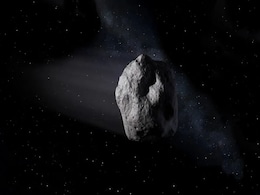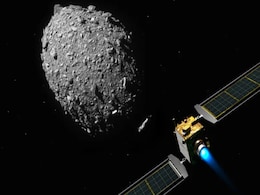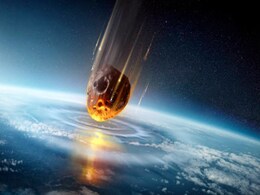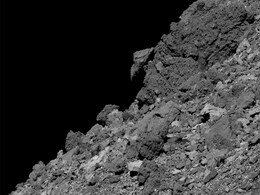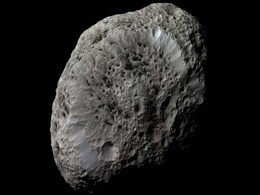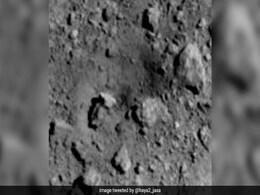Asteroid Crater
- All
- News
-

Study Reveals Earth's Small Asteroid Likely Originated from the Moon
- Monday January 27, 2025
- Written by Gadgets 360 Staff
Asteroid 2024 PT5, discovered near Earth in 2024, is suspected to be a fragment from the Moon’s surface. Researchers found its composition matches lunar rock samples, specifically silicate-rich materials, unlike any known asteroid. Analysis from NASA’s Center for Near Earth Object Studies confirmed it is a natural object, not human-made debris,...
-
 www.gadgets360.com
www.gadgets360.com
-

Hera Spacecraft Embarks on Mission to Study Asteroid Redirected by NASA in 2022
- Tuesday October 8, 2024
- Written by Gadgets 360 Staff
The Hera spacecraft has successfully launched from Cape Canaveral, embarking on an international mission to study the asteroid Dimorphos, which was altered in course by NASA’s Double Asteroid Redirection Test (DART) in 2022. Expected to reach its target by December 2026, Hera will examine the impact crater left by the DART mission and deploy two ...
-
 www.gadgets360.com
www.gadgets360.com
-

Scientists Reveal It Wasn't Just One Asteroid That Wiped Out Dinosaurs
- Friday October 4, 2024
- Science | Edited by NDTV News Desk
The massive asteroid that ended the dinosaurs 66 million years ago was not an isolated event, new research has revealed.
-
 www.ndtv.com
www.ndtv.com
-

Could Earth Have Had Rings Like Saturn? Study Suggests Asteroid Breakup and Cooling Climate
- Wednesday September 18, 2024
- Written by Gadgets 360 Staff
Scientists have proposed that Earth may once have had a ring system similar to Saturn’s, formed by an asteroid breakup 466 million years ago. This ring may have triggered global cooling, contributing to the Hirnantian Ice Age. Evidence includes impact craters near the equator and meteorite debris in sedimentary rocks.
-
 www.gadgets360.com
www.gadgets360.com
-

Study Of Craters Suggests Earth Once Had Saturn-Like Rings
- Wednesday September 18, 2024
- Science | Edited by Amit Chaturvedi
The study said that the asteroid belt was formed due to the break-up of an asteroid passing within Earth's Roche limit.
-
 www.ndtv.com
www.ndtv.com
-

Asteroid Impact Reoriented Jupiter’s Largest Moon Ganymede 4 Billion Years Ago
- Sunday September 8, 2024
- NDTV
A colossal asteroid impact about 4 billion years ago dramatically altered Ganymede, Jupiter's largest moon. The asteroid, estimated to be 186 miles wide, struck Ganymede with such force that it reoriented the moon and removed a significant portion of its original surface. This impact not only created a massive crater but also affected Ganymede's in...
-
 www.gadgets360.com
www.gadgets360.com
-

Apart From Chicxulub, Another Asteroid Might Have Contributed to Dinosaur Extinction
- Thursday August 18, 2022
- Edited by Gadgets 360 Newsdesk
A mysterious asteroid impact crater have been spotted on the seafloor which is believed to have formed at the same time when dinosaurs were wiped out from the planet. This could mean that not one, but two asteroid impacts were behind the extinction of dinosaurs.
-
 www.gadgets360.com
www.gadgets360.com
-

Scientists Discover Undersea Crater Created When Dinosaurs Disappeared
- Thursday August 18, 2022
- Science | Edited by Amit Chaturvedi
The researchers have named the other crater as Nadir. It is more than 300 metres below the seabed, some 400 km off the coast of Guinea.
-
 www.ndtv.com
www.ndtv.com
-

Asteroid Bennu's Boulders Act as 'Body Armour' Against Small Meteoroids, Say Researchers
- Saturday June 18, 2022
- Edited by Gadgets 360 Newsdesk
Scientists think that the boulders on the surface of Asteroid Bennu might be acting as a shield against meteoroids. When a meteoroid collides with Bennu, which is a rubber-pile asteroid formed from a much bigger asteroid, it ends up fracturing, chipping, or breaking apart the boulders. Impactors also create smaller craters on Bennu due to the boul...
-
 www.gadgets360.com
www.gadgets360.com
-

ESA Shares Photo Of One of The Biggest Impact Basins On Martian Surface
- Saturday November 6, 2021
- Edited by Gadgets 360 Newsdesk
The European Space Agency (ESA) has shared stunning images of one of the biggest impact basins in the Solar System, located on Mars. Hellas, with a diameter of 1,430 miles (2,300km) and a depth of over 4.3 miles (7km), is believed to have formed between 3.8 billion and 4.1 billion years ago after a large asteroid hit the surface of Mars.
-
 www.gadgets360.com
www.gadgets360.com
-

World Asteroid Day 2020: Why Is It Observed And All You Need To Know
- Tuesday June 30, 2020
- India News | Edited by Debjani Chatterjee
World Asteroid Day 2020: In December 2016, the UN General Assembly adopted a resolution in order to "observe each year, at the international level, the anniversary of the Tunguska impact over Siberia, on 30 June 1908, and to raise public awareness about the asteroid impact hazard."
-
 www.ndtv.com
www.ndtv.com
-

Japan Creates First Artificial Crater On Asteroid
- Thursday April 25, 2019
- Science | Agence France-Presse
Japanese scientists have succeeded in creating what they called the first-ever artificial crater on an asteroid, a step towards shedding light on how the solar system evolved, the country's space agency said Thursday.
-
 www.ndtv.com
www.ndtv.com
-

Japan Space Agency's Probe Sends Impactor To Blast Asteroid
- Friday April 5, 2019
- Science | Agence France-Presse
A Japanese probe on Friday launched an explosive device at an asteroid, aiming to blast a crater in the surface and scoop up material that could shed light on how the solar system evolved.
-
 www.ndtv.com
www.ndtv.com
-

Fossils Show World-Wide Catastrophe On The Day Dinosaurs Died
- Saturday March 30, 2019
- Science | Ben Guarino, The Washington Post
Sixty-six million years ago, a massive asteroid crashed into a shallow sea near Mexico. The impact carved out a 90-mile-wide crater and flung mountains of earth into space. Earthbound debris fell to the planet in droplets of molten rock and glass.
-
 www.ndtv.com
www.ndtv.com
-

Study Reveals Earth's Small Asteroid Likely Originated from the Moon
- Monday January 27, 2025
- Written by Gadgets 360 Staff
Asteroid 2024 PT5, discovered near Earth in 2024, is suspected to be a fragment from the Moon’s surface. Researchers found its composition matches lunar rock samples, specifically silicate-rich materials, unlike any known asteroid. Analysis from NASA’s Center for Near Earth Object Studies confirmed it is a natural object, not human-made debris,...
-
 www.gadgets360.com
www.gadgets360.com
-

Hera Spacecraft Embarks on Mission to Study Asteroid Redirected by NASA in 2022
- Tuesday October 8, 2024
- Written by Gadgets 360 Staff
The Hera spacecraft has successfully launched from Cape Canaveral, embarking on an international mission to study the asteroid Dimorphos, which was altered in course by NASA’s Double Asteroid Redirection Test (DART) in 2022. Expected to reach its target by December 2026, Hera will examine the impact crater left by the DART mission and deploy two ...
-
 www.gadgets360.com
www.gadgets360.com
-

Scientists Reveal It Wasn't Just One Asteroid That Wiped Out Dinosaurs
- Friday October 4, 2024
- Science | Edited by NDTV News Desk
The massive asteroid that ended the dinosaurs 66 million years ago was not an isolated event, new research has revealed.
-
 www.ndtv.com
www.ndtv.com
-

Could Earth Have Had Rings Like Saturn? Study Suggests Asteroid Breakup and Cooling Climate
- Wednesday September 18, 2024
- Written by Gadgets 360 Staff
Scientists have proposed that Earth may once have had a ring system similar to Saturn’s, formed by an asteroid breakup 466 million years ago. This ring may have triggered global cooling, contributing to the Hirnantian Ice Age. Evidence includes impact craters near the equator and meteorite debris in sedimentary rocks.
-
 www.gadgets360.com
www.gadgets360.com
-

Study Of Craters Suggests Earth Once Had Saturn-Like Rings
- Wednesday September 18, 2024
- Science | Edited by Amit Chaturvedi
The study said that the asteroid belt was formed due to the break-up of an asteroid passing within Earth's Roche limit.
-
 www.ndtv.com
www.ndtv.com
-

Asteroid Impact Reoriented Jupiter’s Largest Moon Ganymede 4 Billion Years Ago
- Sunday September 8, 2024
- NDTV
A colossal asteroid impact about 4 billion years ago dramatically altered Ganymede, Jupiter's largest moon. The asteroid, estimated to be 186 miles wide, struck Ganymede with such force that it reoriented the moon and removed a significant portion of its original surface. This impact not only created a massive crater but also affected Ganymede's in...
-
 www.gadgets360.com
www.gadgets360.com
-

Apart From Chicxulub, Another Asteroid Might Have Contributed to Dinosaur Extinction
- Thursday August 18, 2022
- Edited by Gadgets 360 Newsdesk
A mysterious asteroid impact crater have been spotted on the seafloor which is believed to have formed at the same time when dinosaurs were wiped out from the planet. This could mean that not one, but two asteroid impacts were behind the extinction of dinosaurs.
-
 www.gadgets360.com
www.gadgets360.com
-

Scientists Discover Undersea Crater Created When Dinosaurs Disappeared
- Thursday August 18, 2022
- Science | Edited by Amit Chaturvedi
The researchers have named the other crater as Nadir. It is more than 300 metres below the seabed, some 400 km off the coast of Guinea.
-
 www.ndtv.com
www.ndtv.com
-

Asteroid Bennu's Boulders Act as 'Body Armour' Against Small Meteoroids, Say Researchers
- Saturday June 18, 2022
- Edited by Gadgets 360 Newsdesk
Scientists think that the boulders on the surface of Asteroid Bennu might be acting as a shield against meteoroids. When a meteoroid collides with Bennu, which is a rubber-pile asteroid formed from a much bigger asteroid, it ends up fracturing, chipping, or breaking apart the boulders. Impactors also create smaller craters on Bennu due to the boul...
-
 www.gadgets360.com
www.gadgets360.com
-

ESA Shares Photo Of One of The Biggest Impact Basins On Martian Surface
- Saturday November 6, 2021
- Edited by Gadgets 360 Newsdesk
The European Space Agency (ESA) has shared stunning images of one of the biggest impact basins in the Solar System, located on Mars. Hellas, with a diameter of 1,430 miles (2,300km) and a depth of over 4.3 miles (7km), is believed to have formed between 3.8 billion and 4.1 billion years ago after a large asteroid hit the surface of Mars.
-
 www.gadgets360.com
www.gadgets360.com
-

World Asteroid Day 2020: Why Is It Observed And All You Need To Know
- Tuesday June 30, 2020
- India News | Edited by Debjani Chatterjee
World Asteroid Day 2020: In December 2016, the UN General Assembly adopted a resolution in order to "observe each year, at the international level, the anniversary of the Tunguska impact over Siberia, on 30 June 1908, and to raise public awareness about the asteroid impact hazard."
-
 www.ndtv.com
www.ndtv.com
-

Japan Creates First Artificial Crater On Asteroid
- Thursday April 25, 2019
- Science | Agence France-Presse
Japanese scientists have succeeded in creating what they called the first-ever artificial crater on an asteroid, a step towards shedding light on how the solar system evolved, the country's space agency said Thursday.
-
 www.ndtv.com
www.ndtv.com
-

Japan Space Agency's Probe Sends Impactor To Blast Asteroid
- Friday April 5, 2019
- Science | Agence France-Presse
A Japanese probe on Friday launched an explosive device at an asteroid, aiming to blast a crater in the surface and scoop up material that could shed light on how the solar system evolved.
-
 www.ndtv.com
www.ndtv.com
-

Fossils Show World-Wide Catastrophe On The Day Dinosaurs Died
- Saturday March 30, 2019
- Science | Ben Guarino, The Washington Post
Sixty-six million years ago, a massive asteroid crashed into a shallow sea near Mexico. The impact carved out a 90-mile-wide crater and flung mountains of earth into space. Earthbound debris fell to the planet in droplets of molten rock and glass.
-
 www.ndtv.com
www.ndtv.com

